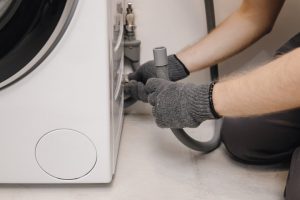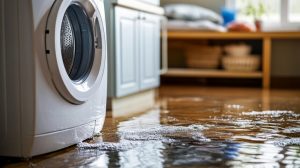Stop washer overflows, slow utility sinks, and floor drain backups—fast, clean fixes that last.
Call WI: (262) 515-9151 • Call IL: (847) 350-8383 • Book Online
Why your laundry drain is overflowing (and what we do about it)
Laundry lines carry lint, soap, fabric softener, and sand/grit—a recipe for clogs in the standpipe, P‑trap, trap arm, utility sink branch, and the tie‑in to the main sewer. High‑efficiency washers discharge water fast; if the line can’t keep up, the standpipe or nearby floor drain will overflow.
Common symptoms:
- Washer standpipe overflows mid‑cycle
- Utility sink fills or gurgles when the washer drains
- Floor drain backs up after laundry loads
- Sour or sewer odors near the washer/sink
- Clogs that return quickly after DIY chemicals
Get Same‑Day Laundry Drain Service or call (262) 515‑9151.
Our 4‑Step Laundry Line Cleaning Process
 1. Diagnose
1. Diagnose
We identify access (standpipe, sink trap, nearby cleanout), check standpipe height/routing, and—when helpful—use a micro‑camera to locate the restriction and check the tie‑in to the main.
2. Clean
We match the method to your pipe size and condition:
- Professional cabling/rodding to cut lint/soap mats from 1½–2” branches
- Small‑line hydro‑jetting to scrub pipe walls for a longer‑lasting clean
3. Verify
We run a full wash/drain test and sink test to confirm flow and check for leaks at traps and connections.
4. Prevent
We review best practices, offer enzyme treatment, and can add lint capture at the discharge line. If symptoms suggest a broader issue, we may recommend a camera inspection of the main sewer.
Clear My Laundry Drain Now — Technicians on call 24/7.
What causes laundry drain clogs and backups?
- Lint + soap scum combining into dense mats in the standpipe and trap arm
- High‑flow discharge from modern washers overwhelming partially restricted lines
- Powdered detergent residue and fabric softener buildup
- Scale/corrosion inside cast‑iron or galvanized lines
- Downstream/main‑line restriction sending water back to the lowest drains

If we find damage or a main‑line issue, we’ll show you on camera and outline repair options—no pressure, just facts.
Washer & Utility Sink Help
- Standpipe height/routing check to reduce splash‑over and siphoning
- Utility sink augering and P‑trap reseal
- Lint filter options for the discharge hose
- Floor drain odor fixes (trap primer checks) and clearing
Talk to a Tech in Kenosha/Racine, or call (847) 350‑8383 for Illinois border communities.
Transparent Pricing & Options

You’ll get a clear, upfront price after a quick diagnosis. If small‑line jetting or camera inspection adds value, we’ll explain why and get your okay first. No surprises. Ask about our limited warranty on cleared lines (line condition applies).
Popular add‑ons:
- Micro‑camera inspection with saved clips
- Small‑line hydro‑jetting for heavy lint/soap lines
- Enzyme treatment and maintenance schedule (6–12 months for busy households)
Request a Quote — Ask about today’s same‑day openings.
Laundry Line vs. Main Line—Which is it?
If tubs, toilets, or the floor drain also back up—especially during showers—the issue may be downstream in the main sewer. We’ll diagnose and clear the right section so the problem doesn’t return.
See Floor Drain Clearing and Main Sewer Line Cleaning.
Do’s & Don’ts for a Trouble‑Free Laundry Drain
Do:
- Clean the washer’s filter and use HE detergent per manufacturer guidelines
- Add a lint trap to the discharge hose
- Run a monthly enzyme treatment for heavy‑use homes
Don’t:
- Pour chemical drain openers—they can damage pipes and create hazards
- Route the discharge hose too deep into the standpipe (siphon risk)
- Ignore sewer odors—they can indicate a dry trap or restriction
Service Area
Proudly serving Kenosha, Racine, Pleasant Prairie, Mount Pleasant, Sturtevant, Union Grove, Burlington, Somers, Bristol, Salem Lakes, Paddock Lake, Twin Lakes, Lake Geneva, and surrounding communities.
See All Service Areas or call (262) 515‑9151.
FAQs: Laundry Drain Cleaning
Why does my standpipe overflow but the sink seems fine?
The standpipe sees a fast surge; a partial restriction downstream can handle slow sink flow but not a full washer discharge.
Why do I smell sewer near the washer?
A dry trap or blocked vent can cause odors. We’ll diagnose and fix the root cause.
How long does service take?
Most laundry line cleanings take 45–90 minutes; jetting or camera work may add time.
Will you make a mess?
We use mats and covers to protect floors and walls, and we clean up before we leave.
Ready to do laundry without the puddles?
- Call WI: (262) 515‑9151
- Call IL: (847) 350‑8383
- Or Book Online in under 60 seconds.
